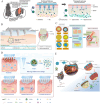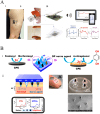The application prospect of microneedles for sports injuries: a narrative review
- PMID: 40771103
- PMCID: PMC12332999
- DOI: 10.1080/07853890.2025.2541092
The application prospect of microneedles for sports injuries: a narrative review
Abstract
Background: The increasing participation in sports, driven by the popularity of physical activity and advancements in sports science, has led to a rise in sports injuries. Traditional treatments for sports injuries typically involve physical therapy and pharmacological interventions. However, drug therapy often suffers from low bioavailability, and analgesic and anti-inflammatory medications may also cause side effects such as gastrointestinal irritation and cardiovascular risks. To amplify the range of therapeutic options in the domain of sports injuries, microneedles (MNs) have emerged as a promising alternative.
Methods: A comprehensive review of English literature from the past two decades and more was performed across multiple databases, including PubMed, Embase, and Web of Science. The search utilized the keywords 'microneedle,' 'sports injury,' 'drug delivery,' etc. Original research articles, clinical studies, and reviews pertinent to the subject were included, while irrelevant and duplicate publications were excluded from the analysis.
Results: The diverse types and materials of MNs make them promising tools for treating sports injuries. These applications facilitate not only the targeted delivery of pharmaceuticals and biological materials but also enable continuous medical supervision through the assessment of subcutaneous metabolites.
Conclusion: The application of MNs in the management of sports injuries holds significant promise for therapeutic interventions and medical monitoring, offering valuable insights for future innovation in sports science applications.
Keywords: Microneedles; sports injuries; sports medicine.
Conflict of interest statement
All authors have declared no conflict of interest.
Figures



Similar articles
-
Microneedle-Mediated Delivery for Targeted Cancer Therapy: A Comprehensive Review.Crit Rev Ther Drug Carrier Syst. 2025;42(5):101-120. doi: 10.1615/CritRevTherDrugCarrierSyst.2025053964. Crit Rev Ther Drug Carrier Syst. 2025. PMID: 40743617 Review.
-
Systemic pharmacological treatments for chronic plaque psoriasis: a network meta-analysis.Cochrane Database Syst Rev. 2020 Jan 9;1(1):CD011535. doi: 10.1002/14651858.CD011535.pub3. Cochrane Database Syst Rev. 2020. Update in: Cochrane Database Syst Rev. 2021 Apr 19;4:CD011535. doi: 10.1002/14651858.CD011535.pub4. PMID: 31917873 Free PMC article. Updated.
-
Systemic pharmacological treatments for chronic plaque psoriasis: a network meta-analysis.Cochrane Database Syst Rev. 2021 Apr 19;4(4):CD011535. doi: 10.1002/14651858.CD011535.pub4. Cochrane Database Syst Rev. 2021. Update in: Cochrane Database Syst Rev. 2022 May 23;5:CD011535. doi: 10.1002/14651858.CD011535.pub5. PMID: 33871055 Free PMC article. Updated.
-
The Black Book of Psychotropic Dosing and Monitoring.Psychopharmacol Bull. 2024 Jul 8;54(3):8-59. Psychopharmacol Bull. 2024. PMID: 38993656 Free PMC article. Review.
-
Formulation, sterilization, and clinical evaluation of microneedles for vaccine and biologic delivery: A review.Int J Pharm. 2025 Sep 15;682:125874. doi: 10.1016/j.ijpharm.2025.125874. Epub 2025 Jun 20. Int J Pharm. 2025. PMID: 40544976 Review.
References
-
- Chia L, De Oliveira Silva D, Whalan M, et al. Non-contact anterior cruciate ligament injury epidemiology in team-ball sports: a systematic review with meta-analysis by sex, age, sport, participation level, and exposure type. Sports Med. 2022;52(10):2447–2467. doi: 10.1007/s40279-022-01697-w. - DOI - PMC - PubMed
-
- Bahr R, Clarsen B, Derman W, et al. International Olympic Committee consensus statement: methods for recording and reporting of epidemiological data on injury and illness in sport 2020 (including STROBE Extension for Sport Injury and Illness Surveillance (STROBE-SIIS)). Br J Sports Med. 2020;54(7):372–389. doi: 10.1136/bjsports-2019-101969. - DOI - PMC - PubMed
Publication types
MeSH terms
Substances
LinkOut - more resources
Full Text Sources
Medical
Miscellaneous
